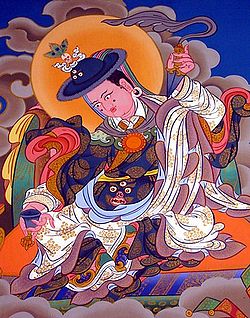Anuyoga
| The Nine Yanas |
| 8. Yana of anuyoga |
| Skt. anuyoga yāna |
| Tib. རྗེས་སུ་རྣལ་འབྱོར་གྱི་ཐེག་པ་ |
| naljor gyü kyi tekpa |
| Wyl. rjes su rnal 'byor gyi theg pa |
| Read main article for nine yana overview |
| Three Outer Yanas Leading From the Origin |
| 1. Shravaka yana |
| 2. Pratyekabuddha yana |
| 3. Bodhisattva yana |
| Three Yanas of Vedic Asceticism |
| 4. Yana of kriya tantra |
| 5. Yana of charya tantra |
| 6. Yana of yoga tantra |
| Three Yanas of Powerful Transformative Methods |
| 7. Yana of tantra mahayoga |
| 8. Yana of scriptural transmission anuyoga |
| 9. Yana of pith instruction atiyoga |
Anuyoga (Skt.; Tib. རྗེས་སུ་རྣལ་འབྱོར་གྱི་ཐེག་པ་, Wyl. rjes su rnal 'byor; Eng. 'subsequent yoga') — the second of the three yanas of powerful transformative methods specific to the Nyingma school.
Anuyoga focuses mainly on the completion stage (Tib. dzogrim), and emphasizes the inner yoga of channels, winds-energies and essences (Tib. tsa lung tiklé). Visualization of the deities is generated instantly, rather than through a gradual process as in Mahayoga.
Overview Given by Alak Zenkar Rinpoche[1]
The vehicle of Anuyoga , or ‘following yoga’, is so-called because it mainly teaches the path of passionately pursuing (or ‘following’) wisdom, in the realization that all phenomena are the creative expression of the indivisible unity of absolute space and primordial wisdom.
Entry Point
One’s mind is matured through the thirty-six empowerments in which the four rivers—outer, inner, accomplishing and secret—are complete, and one keeps the samayas as described in the texts.
View
Through logical reasoning one determines that which is to be known, the fact that all phenomena are characterized as being the three mandalas in their fundamental nature, and realizes that this is so.
Meditation
Meditation practice here consists of two paths. On the path of liberation one practises the non-conceptual samadhi of simply resting in a state that accords with the essence of reality itself, and the conceptual samadhi of deity practice, in which one visualizes the mandala of supporting palace and supported deities simply by reciting the mantra of generation. On the path of skilful means one generates the wisdom of bliss and emptiness through the practices of the upper and lower gateways.
Conduct
One practises the conduct that is beyond adopting or abandoning in the recognition that all perceptions are but the display of the wisdom of great bliss.
Results
At the culmination of Anuyoga’s own uncommon five yogas, which are essentially its five paths, and the ten stages that are included within these five, one attains the level of Samantabhadra.
Subdivisions
There are two sections of Anuyoga:
- sutra (Wyl. mdo)[2] and
- agama (Wyl. lung).
Tantras of Anuyoga
The Anuyoga tantras are classified as:
Four root tantras:
- The Sutra which Gathers All Knowledge: kun 'dus rig pa'i mdo (spyi mdo)
- The Sutra which Gathers All Intentions: sangs rgyas thams chad dgongs pa 'dus pa (Tib. Do Gongpa Düpa or Düpa Do)[3]
- ye shes rngam glog
- gsang ba dur khrod khu byug rol ba
Six branch tantras:
- kun tu bzang po ch'e ba rang la gnas pa'i rgyud
- dbang bskur rgyal po
- ting 'dzin mch'og
- skabs sbyor bdun pa
- srtson pa don ldan
- dam thsig bkod pa
Twelve rare tantras
The Lineage of Anuyoga

King Dza, who also received the Mahayoga tantras, received the Anuyoga tantras from Vajrapani and Licchavi Vimalakirti—one of the Five Excellent Ones of Sublime Nobility who received the Anuyoga tantras from Vajrapani at the summit of Mount Malaya. They were in turn transmitted to the siddha Kukkuraja, and then passed to Nupchen Sangyé Yeshé who taught them in Tibet.[4]
An extensive chronological list of lineage holders of the Mahayoga, from Buddha Samantabhadra to the present day, can be found in Tulku Thondup's works. (see reference below)
Notes
- ↑
 A Brief Presentation of the Nine Yanas by Alak Zenkar Rinpoche
A Brief Presentation of the Nine Yanas by Alak Zenkar Rinpoche
- ↑ The sutras of Anuyoga are different from the shravaka, pratyekabuddha and bodhisattva sutras.
- ↑ P. Cornu says that this tantra is an explanation of the first one. Somehow it seems that these first two root tantras are sometimes amalgamated or confused together in modern sources.
- ↑ This needs to be checked and developed.
Further Reading
- Dudjom Rinpoche, The Nyingma School of Tibetan Buddhism, Its Fundamentals and History, trans. and ed. Gyurme Dorje (Boston: Wisdom Publications, 1991), Book One, Part Four, Ch. 6 'Anuyoga', pages 284-289 & Book Two.
- Jamgön Kongtrul, The Treasury of Knowledge, Book Six, Part Four: Systems of Buddhist Tantra, translated by Elio Guarisco and Ingrid McLeod (Ithaca: Snow Lion, 2005), pages 330-337.
- Khenchen Palden Sherab Rinpoche & Khenpo Tsewang Dongyal Rinpoche, Key to Opening the Wisdom Door of Anuyoga (Padma Samye Ling Shedra Series), (Dharma Samudra, 2015).
- Patrul Rinpoche, The Words of My Perfect Teacher, translated by Padmakara Translation Group (Boston: Shambhala, 1998), pages 334-335.
- Tulku Thondup, Masters of Meditation and Miracles, edited by Harold Talbott (Boston: Shambhala, 1999), pages 28-29.